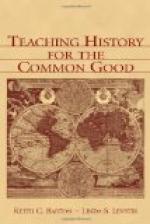IV
THE METHOD OF THE RECITATION
Assumptions as to the recitation room
Let us now assume that the recitation will be held in a quiet room free from the distracting influence of poor light, poor ventilation, and inadequate seating capacity. The blackboard space is ample for the whole class, the erasers and chalk are at hand, the maps, charts, and globe are where they can be used without stumbling over them. The teacher can give his whole attention to the class. Discipline should take care of itself. The pupil who is interested will not be seriously out of order.
What the teacher should aim to accomplish
The problem, then, is so to expend the forty-five minutes in which the teacher and class are together that:—
1. So far as possible
the atmosphere and setting of the period
being
studied may be reproduced.
2. The great historical
characters spoken of in the lesson may
become
for the student real men and women with whom he will
afterwards
feel a personal acquaintance.
3. The events described
will be understood and properly interpreted
in
their relation to geography, and the economic and social
progress
of the world.
4. Causes and effects shall be properly analyzed.
5. And that there
shall be left sufficient time for the occasional
review
necessary to any good instruction.
Work at the blackboard
The first five minutes may profitably be spent at the board, each member of the class being asked to write a complete answer to one of the assigned questions. Whatever may happen later in the recitation each student has had at least this much of an opportunity for self-expression, and his work should be neat, workmanlike, complete, and accurate. By this device the alert teacher will secure in the first five minutes of the recitation hour a fairly accurate idea of each student’s preparation, the weak spots in his understanding of the lesson, and the errors to be corrected. He may even be able to record a grade for the work done.




